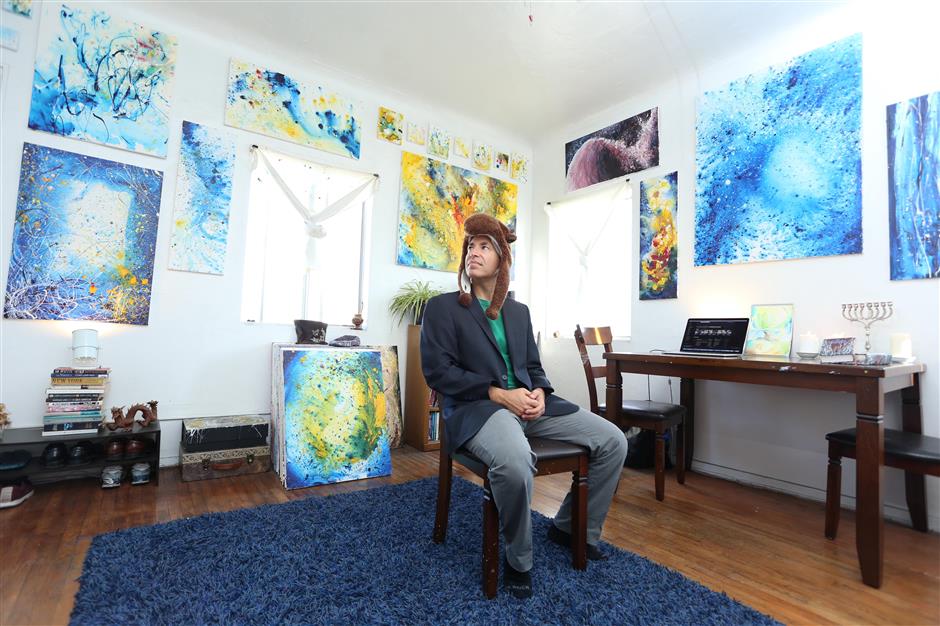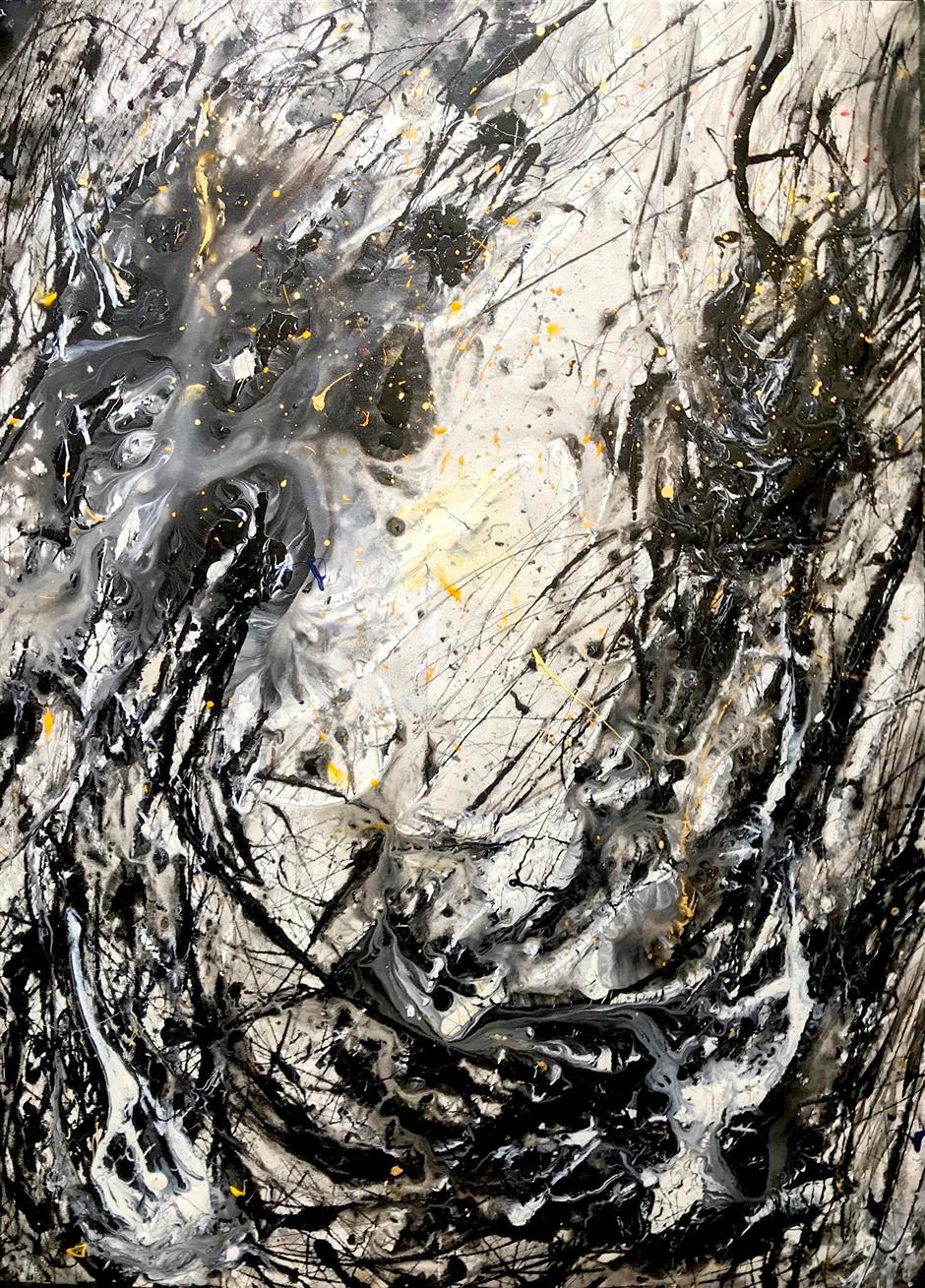Using art as a tool for meditation and healing
Podcast EP16

Ariel Fabian Lijtmaer is envisioning in his studio in US.
Ariel Fabian Lijtmaer leads transformative meditation workshops using art and live music as a way to monitor and support people in mental health and recovery. He sees his artworks as tools to help people enter "gateways" to shatter the limitations of the conscious mind and reach higher levels of awareness. Each piece of art has its own frequency, a different channel or vibration and an access point to a higher realm. Each frequency corresponds to a particular kind of healing energy.
"I encourage you to find the piece of art that resonates with you. Meditate with it, gaze into it and see what opens up within you. Investigate the colors and textures which reflect the subtle movement of your soul. Rewire your brain and create neural platforms of light and inspiration," Lijtmaer beckons the audience.
Born in New York City, Lijtmaer, whose family is from Argentina, is of Ashkenazi Jewish descent.
This week, we continue the talk with Lijtmaer about how art and meditation can combine into a healing program.
Q: You once said it is essential to raise awareness about the way we interact with one another and ourselves. Can you elaborate more on this topic?
A: I would say that I've identified a couple of systems that I have to do every day to interact with myself. First is the morning practice.
We need strength every day. We need strength to stay focused on the things that bring us light. I don't paint every day, but I write every day. I am working on a fantasy mythology called "The Tale of 3." It's influenced by the original "Star Wars" trilogy and "The Lord of the Rings." I'm also creating meditations where you can go on different journeys with each of the characters. I'm also connecting my abstract art to this project. It's a really special project I've been working on for 24 years. I need to spend creative time on this project every day. I know it gives me life.
Also I think people should be very mindful of the media we consume, all kinds of media. A lot of companies take advantage of some of the addictive qualities of the human mind to addict us to certain types of media, which is very unhealthy for us.
I'm also mindful about choosing music to listen to. Music is so critical for my mental wellbeing. Music is also a way to protect my space. And honestly, one challenge for me is I'm always looking for new music. I'm trying to listen to music with new ears all the time. My goal is to listen to the same song that I've heard 10 times before for the first time again. Mindful listening.
And then food – your diet is also very important. I think in general, we eat too much, especially in the United States. Only we're not conscious of the impact that our diet is having on the environment and the Earth.
So check in with your body, check in with yourself. Being gentle with ourselves is another key. And do all these gradually. It's the last thing I'll say. Real change happens gradually.

Ariel Fabian Lijtmaer leads transformative meditation workshops through the media of art and live music.
Q: What's your approach in your healing programs?
A: My group healing programs are usually a combination of indoor and outdoor sections. We go on meditation journeys to rectify energy in our body through the tree of life. Then there's a sharing and reflecting process.
I also combine my artwork and live music with these programs, as well as a spiritual intention. I use the art as a gateway, a portal to help people step into themselves. I found this to be a really powerful practice.
For example, sometimes a program can be about mending – mending the broken vessels or fixing parts of ourselves.
First, I bring people to a place where they are very open grounded and mindful.
And then there's a narrative journey of some kinds. I begin to say almost like a story, but give people the space to envision what they need to envision.
Trying to figure out a way to bring healing into that space, so you can work with some of these energies that maybe we don't realize. When we journey, when you're meditating in a group, it's very interesting, because every person in the circle affects the energetic space and the consciousness of everyone else.
Q: Some people say meditation is an evolving process and doesn't have instant impact. What kind of feedback do you get from your sessions?
A: Yes and no. At least the sessions that I lead with art pieces and music, people report back that they have experiences that they've never had before. In that moment, people feel very whole, connected and close. And I think with a painting alone, at least for me, I can feel something immediately from art.
A painting, in theory, is stagnant, like there's nothing that's moving. But when you're looking at a painting, it doesn't feel stagnant. There is a feedback loop between the viewer and the art. Especially from abstract art, you start seeing more and more, and you begin to interpret. The way it affects you immediately, it's like the pieces are breathing, and my own breath begins to change as a piece is breathing.
I think the impact of art is almost immediate, but how much we internalize it is up to us. Both consciously and unconsciously, if you enter into a space and there's art, or, there's no art there, it also has an unconscious impact.

"Torch of the Bal Shem Tov"
Q: So how do you choose paintings and music for different sessions?
A: It's connected usually to the theme I want to explore. So if we're doing a session on increasing creativity, I might bring some paintings from "the burning bush" series, which is like an opening portal. If I'm doing a session about destroying demons, I might bring a painting that has a lot more red and energy.
Q: In your view, why do color and patterns have strong influences on our emotions?
A: I think colors and patterns can reveal to us an expression of our soul that we can't express – a much higher degree of communication that's possible through colors and lines. There's an idea that everything has a masculine and feminine energy. And I think colors, and lines specifically, help us understand that flow of feminine and masculine and help us tap into and unify the male and female in a way.
And then colors – there's a rainbow right in the rainbow. It's really interesting before you ask, how do you connect something that you don't know is there? I don't know if you try this, but if you're feeling sad or whatever is going on, you can go to a garden or even your kitchen and spray water in the air.

"Mending Broken Vessels"
Directly over that we can create a rainbow whenever we want to, actually. A rainbow has seven colors, right? There are seven notes in a Western music scale and seven days of the week. So the number seven, according to Jewish understanding, is the limit of the physical world, essentially.
This is expanded consciousness. And each color has a certain frequency and creates its own emotional energy or flow.
Q: Has the pandemic affected you and your programs.
A: For sure. The pandemic has given me an opportunity to dive more deeply into the fantasy mythology I am writing. And for the first part of the pandemic, I was writing a lot and then spending time in nature, processing, reflecting and then coming back to write and paint more. Like I was almost in this very mystical, creative bubble, and it was almost nice to have that space.
















